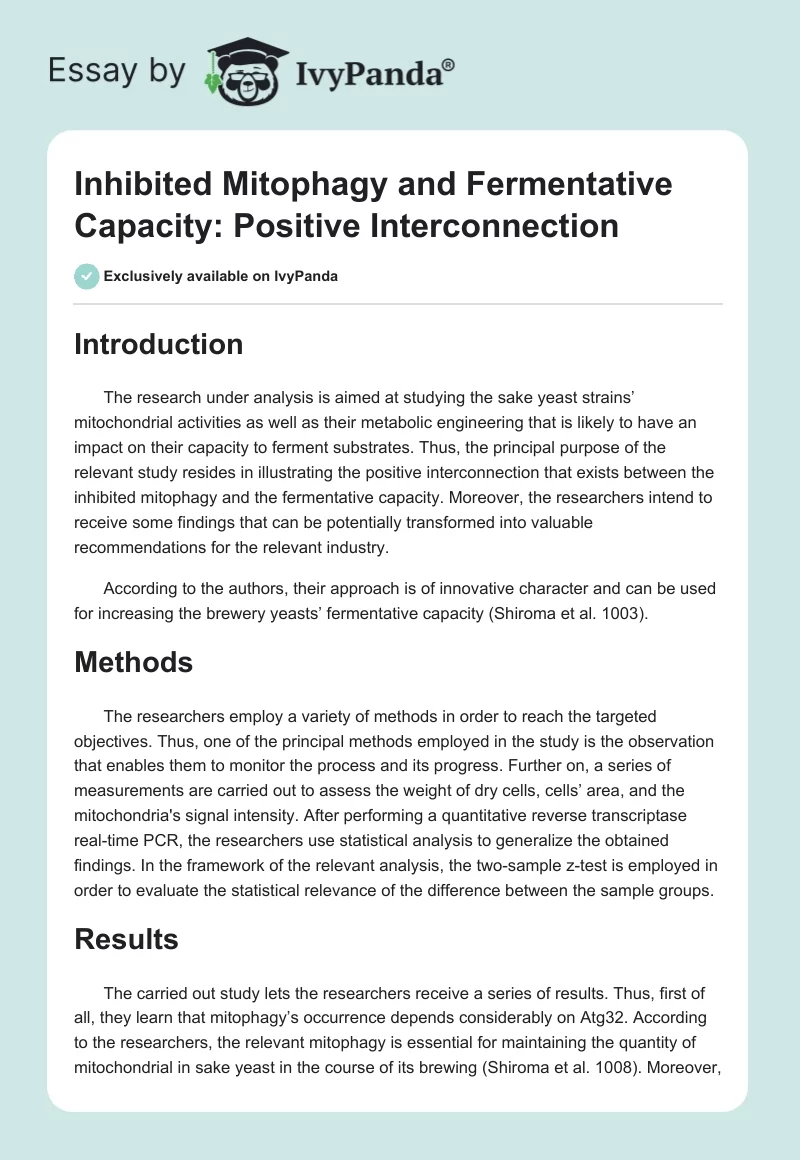Introduction
The research under analysis is aimed at studying the sake yeast strains’ mitochondrial activities as well as their metabolic engineering that is likely to have an impact on their capacity to ferment substrates. Thus, the principal purpose of the relevant study resides in illustrating the positive interconnection that exists between the inhibited mitophagy and the fermentative capacity. Moreover, the researchers intend to receive some findings that can be potentially transformed into valuable recommendations for the relevant industry.
According to the authors, their approach is of innovative character and can be used for increasing the brewery yeasts’ fermentative capacity (Shiroma et al. 1003).
Methods
The researchers employ a variety of methods in order to reach the targeted objectives. Thus, one of the principal methods employed in the study is the observation that enables them to monitor the process and its progress. Further on, a series of measurements are carried out to assess the weight of dry cells, cells’ area, and the mitochondria’s signal intensity. After performing a quantitative reverse transcriptase real-time PCR, the researchers use statistical analysis to generalize the obtained findings. In the framework of the relevant analysis, the two-sample z-test is employed in order to evaluate the statistical relevance of the difference between the sample groups.
Results
The carried out study lets the researchers receive a series of results. Thus, first of all, they learn that mitophagy’s occurrence depends considerably on Atg32. According to the researchers, the relevant mitophagy is essential for maintaining the quantity of mitochondrial in sake yeast in the course of its brewing (Shiroma et al. 1008). Moreover, the first finding lets them discover another phenomenon – mitophagy plays a considerable role in process of the fermentation of ethanol. In other words, mitophagy proves to have an impact not only on the fermentation process but its outcomes as well.
In the course of the research, it is also found out that laboratory and sake yeasts tend to respond in a different manner the concentrations of nutrient. Therefore, the targeted balance might be reached with the regulation of the ethanol concentration.
Conclusion
The researchers draw a conclusion that the occurrence of mitophagy depends significantly on Atg32 in sake yeast in the course of the Ginjo sake’s brewing. They, likewise, point out that atg32″ laboratory yeast tends to improve its fermentation characteristics such as, for example, the concentration of final ethanol and the rate of fermentation.
In the conclusion part, the researchers put a particular emphasis on the fact that there are possibilities for further enhancing of the ethanol’s fermentation rate in the sake yeast. It is noted that the obtained findings are likely to have a positive impact on the bioethanol industry, in general. Due to the fact that the levels required for optima fermentation are often insufficient, the introduced approach can be assistive in producing bioethanol with the use of natural biomass resources.
Finally, the conclusion provides some explanations of the study’s originality and its practical application. The researchers focus on the fact that their work is the first study aimed at examining the role that mitophagy plays in alcoholic fermentation. As a result, it is expected that the received findings that refer to the alcohol industry can be united with the previous results about the general occurrence of mitophagy. The genesis of these ideas is supposed to provide alternative solutions for the bioethanol production, reducing its cost and increasing its productiveness.
Works Cited
Shiroma, Shodai, Lahiru Niroshan Jayakody, Kenta Horie, Koji Okamoto and Hiroshi Kitagakia. “Enhancement of Ethanol Fermentation in Saccharomyces cerevisiae Sake Yeast by Disrupting Mitophagy Function.” Applied and Environmental Microbiology 80.3 (2014): 1002-1012. Print.


